|
Araceae (Arum lily family)
Life
> eukaryotes >
Archaeoplastida >
Chloroplastida
>
Charophyta > Streptophytina > Plantae (land plants)
> Tracheophyta (vascular plants) > Euphyllophyta > Lignophyta (woody plants)
> Spermatophyta (seed plants) > Angiospermae (flowering
plants)
> Monocotyledons > Order: Alismatales
About 106 genera and about 4025 species, native mainly to the tropics and
subtropics, but also with some species in temperate regions; especially diverse in New
World tropics. Ten genera and 33 species are native to southern Africa, two
genera and two species is naturalised, and
a further 16 genera and 39
species are cultivated in the region. The Lemnaceae
has been synonymised with the Araceae and previous members of this family are
included here. They are all aquatic plants with small floating leaves and tiny
flowers.
Genera native to southern Africa
Information from Singh (2000),
Plants
of Southern Africa - an Online Checklist (SANBI),
Flora of
Zimbabwe and
Flora of Mozambique.
|
Amorphophallus
About 150 species, found throughout the Old World tropics, with three
species native to southern Africa and a further species that is cultivated
in the region. The genus includes Amorphophallus titanum (Titan arum)
from Sumatra, which holds the record as the plant with the largest
unbranched inflorescence in the World, with a record height of 2.94 m (see
Wikipedia). |
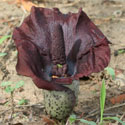 |
|
Culcasia
Twenty species, mainly occurring in the rainforests of western and central
Africa. One species is recorded in Zimbabwe -
Culcasia falcifolia and there is a
record of Culcasia scandens from Gorongoza in Mozambique |
 |
|
Gonatopus
Five species,
found in tropical and southern subtropical Africa, with four species
native to southern Africa, occuring in the northeastern regions. |
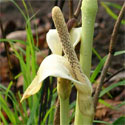 |
|
Lemna
Thirteen species worldwide of which
three are native to southern Africa. Previously placed
in the Lemnaceae. |
|
|
Spirodela
Two of the three species are native to
southern Africa. Previously placed in the Lemnaceae. |
|
|
Stylochaeton
About 15 species, native to tropical and southern subtropical Africa, with
three species native to southern Africa. |
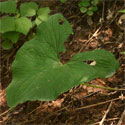 |
|
Wolffia
Three species native to southern
Africa. Previously placed in the Lemnaceae. |
|
|
Wolffiella
Nine species worldwide, with four
species native to southern Africa. |
|
|
Zamioculcas
The only
species is Zamioculcas zamiifolia
(Fern arum), which has a native distribution that includes Kenya,
Tanzania, Malawi, Zimbabwe, Mozambique and South Africa (KwaZulu-Natal). |
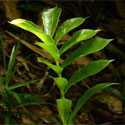 |
|
Zantedeschia
Eight species, all of which are native to southern Africa. |
 |
Genera naturalised in southern Africa
Information from Singh (2000) and
Plants
of Southern Africa - an Online Checklist (SANBI)
|
Colocasia
esculenta (Taro, Cocoyam, or in Zulu 'Amadumbe')
Native to tropical eastern Asia. Grown as a staple food, including in
southern Africa, where it was probably introduced by Portuguese traders
before 1500. It is an occasional escape in Zimbabwe, particular along
watercourses in arid areas. |
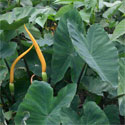 |
|
Pistia
One species,
the Water Lettuce Pistia stratiotes, found worldwide in warm
regions, and a naturalised weed in southern Africa. It is a
declared Category 1 invasive plant
in South Africa. |
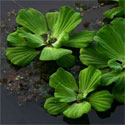 |
Other genera, cultivated in
southern Africa
List from Glen (2002). Acorus was previously placed in the
Araceae but now is placed in its own order (Acorales) and family (Acoraceae).
|
Aglaonema
About 20 species, native to the tropical forests of Asia. Grown particularly
as pot plants. Two species are cultivated in southern Africa:
Aglaonema
commutatum and Aglaonema crispum (latter native to the
Philippines) |
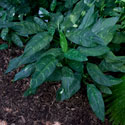 |
|
Alocasia
About 70 species, found in tropical forests and damp, shady places in S and
SE Asia. Five species are cultivated in southern Africa. |
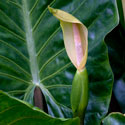 |
|
Anthurium
About 700-900 species found in wet mountain forests of
tropical and subtropical North and South America. Five species are cultivated in
southern Africa. |
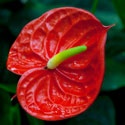 |
|
Arisaema
About 150
species, from moist woodland and rocky wasteland in Asia and North
America. Two species cultivated: Arisaema dracontium and
Arisaema triphyllum, both of which are native to eastern Canada and the
USA. |
|
|
Arisarum vulgare (Friar's cowl)
Native from the Mediterranean to the Azores. |
|
|
Arum
About 26 species, distributed in S Europe, N Africa and W Asia to the W
Himalayas. Two species are cultivated in southern Africa: Arum italicum
(Italian lords-and-ladies) (native from the Canary Islands to Cyprus)
and Arum palaestinum (native to Israel). Other species in the Araceae
are referred to by their common names as arums, e.g.
Zantedeschia aethiopica. |
|
|
Caladium bicolor
Native to northern South America. |
|
|
Dieffenbachia seguine
(Dumb cane)
Native to tropical America. |
|
|
Dracunculus vulgaris (Dragon Arum)
Native from Corsica to Turkey. |
|
Epipremnum pinnatum
(Money plant)
Native from Malaysia to New Guinea. |
|
|
Monstera deliciosa (Delicious Monster)
The Delicious Monster is widely cultivated in gardens and is so called
because the ripe fruit can be eaten. Eating the unripe fruit is not
recommended because it contains calcium oxalate crystals. |
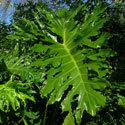 |
|
Montrichardia linifera
Native to northern South America. |
|
|
Philodendron
About 500 species, native to the Americas, mainly in rain forest. Eight
species are cultivated in southern Africa. |
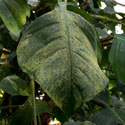 |
|
Spathiphyllum
A total of 36 species, native to tropical regions of Indonesia, the
Philippines and the Americas. Often grown as indoor plants. Three species
are cultivated in southern Africa. |
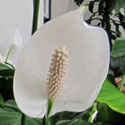 |
|
Syngonium
About 33 species, native to Central and South America. Two species are
cultivated in southern Africa: Syngonium macrophylla (native from
Mexico to Ecuador) and Syngonium podophyllum (native from Mexico to
Bolivia). |
|
|
Typhonium
About 40 species, native to SE Asia, Indomalesia, northeastern Australia and
Africa. Two species are cultivated in southern Africa: Typhonium blumei
(native to China and Japan) and Typhonium venosum (Voodoo lily)
[= Sauromatum venosum] (native to the Old World tropics, from West Africa to Burma. Inflorescences
have a foetid smell). |
|
Characteristics (excluding genera previously in Lemnaceae)
Flowers
The following characteristics distinguish members of the
Araceae from other families:
- they have an inflorescence termed a spadix
consisting of small closely packed flowers arranged round a swollen, fleshy
column.
- the spadix has a (usually) large, petal-like bract
wrapped round its base termed a spathe.
Some species have separate male and female (i.e.
unisexual) flowers (e.g. Arum Lily Zantedeschia
aethiopica) while in other species male and female parts are combined in
one (i.e. bisexual) flower (e.g. Anthurium, Monstera). In species with
unisexual flowers, the male flowers are at the top and the female flowers at the
bottom of the spadix.
Leaves
- simple or compound
- venation parallel, pinnate or palmate
- the petiole of the leaf has a membranous sheathing
base.
- the leaves of the Delicious Monster Monstera
deliciosa have large holes in them.
Roots
Adventious
Fruit
A berry, i.e. a fleshy fruit without a stony layer
containing one to many seeds.
Publications
-
Bogner, J. & Nicolson, D.H. 1991. A
revised classification of Araceae with dichotomous keys. Willdenowia
21: 35-50.
-
Brickell, C. (ed.) 1996. The Royal
Horticultural Society A-Z Encyclopedia of Garden Plants. Dorling
Kindersley, London.
-
Glen, R.P. 2000. Lemanceae. In: Seed Plants of
Southern Africa (ed. O.A. Leistner). Strelitzia 10: 640-641.
National Botanical Institute, Pretoria.
-
Glen, H.F. 2002. Cultivated Plants of
Southern Africa. Jacana, Johannesburg.
-
Mayo, S.J. 1985. Araceae. Flora of Tropical
East Africa: 1-71.
-
Mayo, S.J., Bogner, J. & Boyce, P.C. 1997.
The Genera of Araceae. Royal Botanic Gardens, Kew.
-
Walters, S.M. et al. (eds). Araceae. In: European
Garden Flora 2: 75-112.
-
Singh, Y. 2000. Araceae. In: Seed Plants of
Southern Africa (ed. O.A. Leistner). Strelitzia 10: 578-580.
National Botanical Institute, Pretoria.
|
